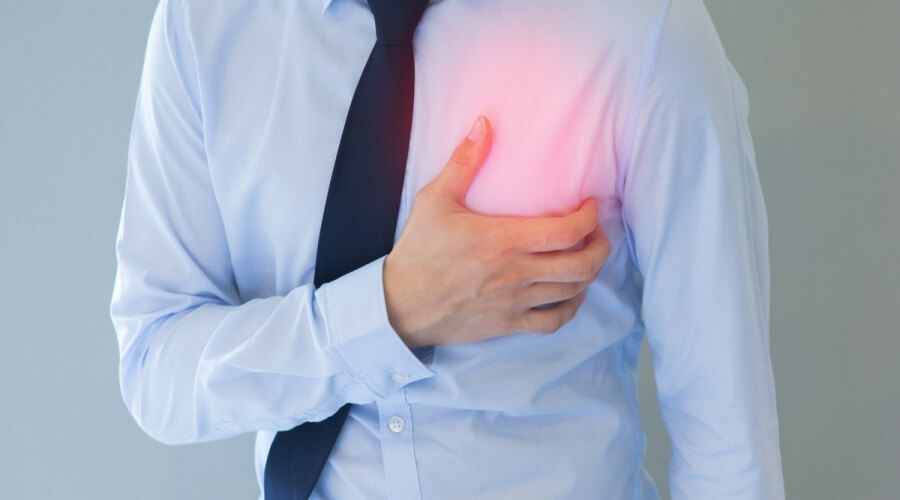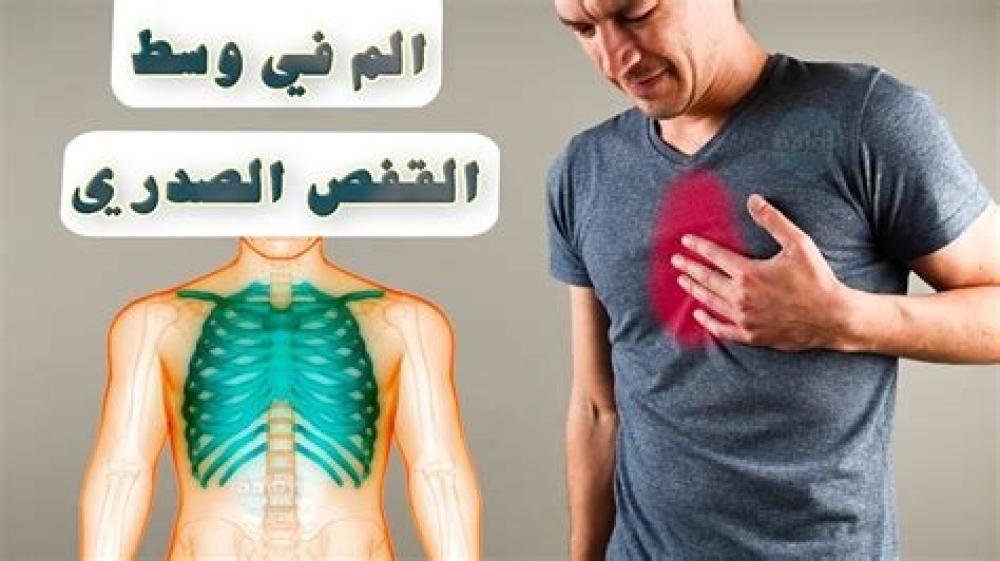You can sometimes feel unexplained chest pain or when you make a great effort, such as climbing the stairs or walking quickly, but have you wondered about the causes of pain and why you feel it without warning? This is what we will learn about in the article and how to find the appropriate treatment for pain in the middle of the rib cage when breathing.
The rib cage consists of bones that surround the lungs on both sides and the heart to protect it from any injury that might harm it. However, some people are confused when they know the type of this pain and whether it is specific to the bones of the rib cage or whether the problem is in the lungs and heart when breathing.

Pain in the middle of the rib cage
Causes of pain when breathing
Pain appears in the middle of the rib cage when breathing for several reasons, including:
Infections
Although the common cold is associated with minor problems and hearing a whistling sound when breathing, there are serious medical conditions that can also cause the same pain.
- Pneumonia: It is a chest infection that is often viral, bacterial, or fungal.
- Tuberculosis or tuberculosis: It appears as a result of a serious bacterial infection.
- Pleuritis: This type of inflammation appears in the inner membrane of the lung or pulmonary cavity and is often caused by infection.
- Bronchitis: It is an infection or inflammation of the respiratory tract within the lungs.
- Herpes zoster: This is a painful infection caused by the resuscitation of the chickenpox virus.
Infection with the Coronavirus COVID-19
The appearance of pain in the middle of the rib cage when breathing is often associated with infection with the new Corona virus, so you must immediately go to the hospital if chest pain is accompanied by the following symptoms:
- Fever and chills
- General fatigue in the body
- Muscle pain
- Loss of the ability to taste and smell
- Sore throat
Chest pain can continue if the diagnosis is confirmed for three months or more, depending on each case.
Lung Diseases
Some chronic chest conditions can cause pain in the middle of the rib cage when breathing, and unlike temporary infections, breathing problems are long-lasting.
These diseases include the following:
- Chronic obstructive pulmonary disease: It is a group of chest diseases, the most famous of which is emphysema.
- Chest allergy, also known as asthma
- Diseases resulting from inhalation of chemicals and fumes
- Broken ribs of the rib cage.
- Pulmonary embolism results from a blockage of one of the lung arteries.
- Pneumothorax appears as a result of lung atelectasis.
- Suppuration or pulmonary empyema is the collection of infectious pus in the inner lining of the chest cavity.
- Costochondritis: This inflammation appears between the ribs, breastbone, and marrow, causing chest pain.
Heart Diseases
Heart problems cause pain in the middle of the rib cage when breathing and may also be accompanied by shortness of breath and discomfort. Therefore, a high percentage of heart patients must go for periodic follow-up with the treating physician and also go immediately to the emergency room if they feel this pain. There are several diseases that cause pain when breathing, including:
- Angina: due to decreased blood flow to the heart.
- Thrombosis: occurs as a result of complete obstruction of blood flow to the heart.
- Heart failure or cardiac arrest: the result of the heart's inability to pump blood properly.
- Myocarditis
- Inflammation of the pericardium
Chest pain associated with heart disease is often accompanied by other symptoms such as nausea, dizziness, sweating, and pain in the upper abdomen, and the pain can radiate to the neck, jaw, arms, or shoulders.
GERD
The patient suffers from esophageal reflux as a result of the reflux of food and stomach acid from the stomach into the esophagus. This causes a feeling of heartburn, or what is known as heartburn, and is accompanied by other symptoms, including:
- Nausea
- Bad breath
- Difficulty swallowing
Panic attack
Chest pain when breathing can be the result of a non-physical cause and appear as a result of a feeling of fear, sudden panic, or tension. The patient is always confused between the symptoms of panic or a heart attack and a chest attack, so there are distinct symptoms of such a condition in addition to chest pain while breathing, such as:
- Rapid heartbeat.
- Sweating
- Tremor and movement disorder
- shortness of breath
- Vertigo
- Dissipation of reality and loss of feeling of it
However, a panic attack does not last long and usually subsides in ten minutes or less.
Diagnosis and doctor consultation
The doctor diagnoses the condition by knowing the patient's medical history and family history of heart and lung diseases, and by examining the symptoms appearing on the patient during his visit.
He also requests various tests to determine the cause and confirm his initial diagnosis of the condition, such as:
- Chest X-ray
- transsectional rays
- Blood and urine analysis
- Electrocardiogram
- Measure the number of heart beats per minute
- Echocardiogram
- Heart and lung functions
You must go to the emergency room immediately if the patient feels chest pain when breathing and other symptoms appear, such as:
- Feeling of a fracture in the chest bone.
- Pain spreads to the jaw, left arm, or back.
- Rapid breathing.
- Rave.
- Feeling a rapid heartbeat.
protection
Treating the feeling of pain in the middle of the rib cage when breathing is related to knowing the cause, and then the pain disappears with taking medications and following the necessary home instructions.
However, it is easy to avoid feeling this pain by following the following instructions:
- stop smoking.
- Avoid being around smokers.
- Avoid being in closed places for long periods.
- Avoid breathing toxic fumes and chemicals at work.
- Avoid inhaling odors that increase chest sensitivity.
- Weight loss if the patient is obese.
- Working to reduce high blood pressure in patients with high blood pressure.
- Reducing high cholesterol levels.
- Exercise daily.
- Practice yoga and breathing exercises periodically.
- Avoid eating fatty foods and salts.
- Controlling blood sugar levels in diabetics.
- Sleeping Early.
- Eat plenty of fresh fruits and vegetables during the day.
- Follow a diet low in starches and sugar.
- Avoid eating late and right before bed.
- Avoid lying down immediately after meals.
- Reducing the consumption of soft drinks to reduce the severity of stomach infections.
- Avoid drinking too much coffee and tea before bed.
- Sleep on a high pillow to avoid esophageal reflux in the future.

